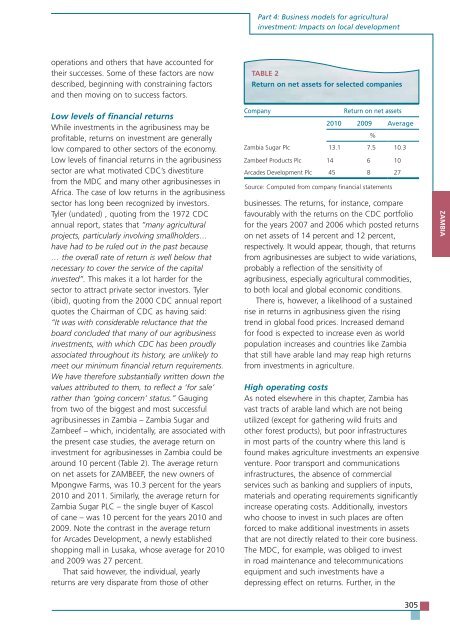TRENDS AND IMPACTS OF FOREIGN INVESTMENT IN DEVELOPING COUNTRY AGRICULTURE
TRENDS AND IMPACTS OF FOREIGN INVESTMENT IN DEVELOPING COUNTRY AGRICULTURE
TRENDS AND IMPACTS OF FOREIGN INVESTMENT IN DEVELOPING COUNTRY AGRICULTURE
Create successful ePaper yourself
Turn your PDF publications into a flip-book with our unique Google optimized e-Paper software.
operations and others that have accounted for<br />
their successes. Some of these factors are now<br />
described, beginning with constraining factors<br />
and then moving on to success factors.<br />
Low levels of financial returns<br />
While investments in the agribusiness may be<br />
profitable, returns on investment are generally<br />
low compared to other sectors of the economy.<br />
Low levels of financial returns in the agribusiness<br />
sector are what motivated CDC’s divestiture<br />
from the MDC and many other agribusinesses in<br />
Africa. The case of low returns in the agribusiness<br />
sector has long been recognized by investors.<br />
Tyler (undated) , quoting from the 1972 CDC<br />
annual report, states that “many agricultural<br />
projects, particularly involving smallholders…<br />
have had to be ruled out in the past because<br />
… the overall rate of return is well below that<br />
necessary to cover the service of the capital<br />
invested”. This makes it a lot harder for the<br />
sector to attract private sector investors. Tyler<br />
(ibid), quoting from the 2000 CDC annual report<br />
quotes the Chairman of CDC as having said:<br />
“It was with considerable reluctance that the<br />
board concluded that many of our agribusiness<br />
investments, with which CDC has been proudly<br />
associated throughout its history, are unlikely to<br />
meet our minimum financial return requirements.<br />
We have therefore substantially written down the<br />
values attributed to them, to reflect a ‘for sale’<br />
rather than ‘going concern’ status.” Gauging<br />
from two of the biggest and most successful<br />
agribusinesses in Zambia – Zambia Sugar and<br />
Zambeef – which, incidentally, are associated with<br />
the present case studies, the average return on<br />
investment for agribusinesses in Zambia could be<br />
around 10 percent (Table 2). The average return<br />
on net assets for ZAMBEEF, the new owners of<br />
Mpongwe Farms, was 10.3 percent for the years<br />
2010 and 2011. Similarly, the average return for<br />
Zambia Sugar PLC – the single buyer of Kascol<br />
of cane – was 10 percent for the years 2010 and<br />
2009. Note the contrast in the average return<br />
for Arcades Development, a newly established<br />
shopping mall in Lusaka, whose average for 2010<br />
and 2009 was 27 percent.<br />
That said however, the individual, yearly<br />
returns are very disparate from those of other<br />
Part 4: Business models for agricultural<br />
investment: Impacts on local development<br />
TABLE 2<br />
Return on net assets for selected companies<br />
Company Return on net assets<br />
2010 2009 Average<br />
Zambia Sugar Plc 13.1<br />
%<br />
7.5 10.3<br />
Zambeef Products Plc 14 6 10<br />
Arcades Development Plc 45 8 27<br />
Source: Computed from company financial statements<br />
businesses. The returns, for instance, compare<br />
favourably with the returns on the CDC portfolio<br />
for the years 2007 and 2006 which posted returns<br />
on net assets of 14 percent and 12 percent,<br />
respectively. It would appear, though, that returns<br />
from agribusinesses are subject to wide variations,<br />
probably a reflection of the sensitivity of<br />
agribusiness, especially agricultural commodities,<br />
to both local and global economic conditions.<br />
There is, however, a likelihood of a sustained<br />
rise in returns in agribusiness given the rising<br />
trend in global food prices. Increased demand<br />
for food is expected to increase even as world<br />
population increases and countries like Zambia<br />
that still have arable land may reap high returns<br />
from investments in agriculture.<br />
High operating costs<br />
As noted elsewhere in this chapter, Zambia has<br />
vast tracts of arable land which are not being<br />
utilized (except for gathering wild fruits and<br />
other forest products), but poor infrastructures<br />
in most parts of the country where this land is<br />
found makes agriculture investments an expensive<br />
venture. Poor transport and communications<br />
infrastructures, the absence of commercial<br />
services such as banking and suppliers of inputs,<br />
materials and operating requirements significantly<br />
increase operating costs. Additionally, investors<br />
who choose to invest in such places are often<br />
forced to make additional investments in assets<br />
that are not directly related to their core business.<br />
The MDC, for example, was obliged to invest<br />
in road maintenance and telecommunications<br />
equipment and such investments have a<br />
depressing effect on returns. Further, in the<br />
305<br />
ZAMBIA


